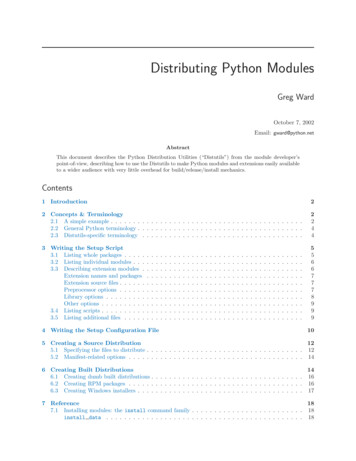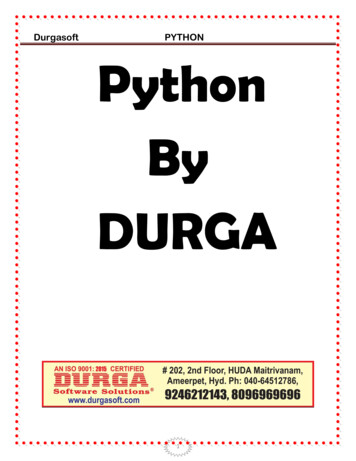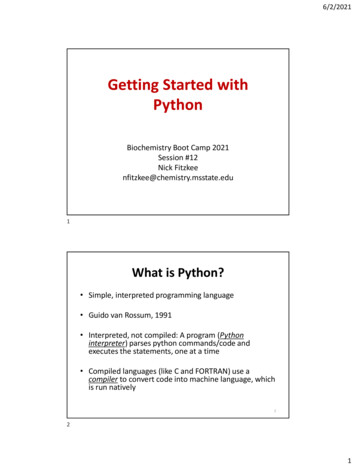
Transcription
Distributing Python ModulesGreg WardOctober 7, 2002Email: gward@python.netAbstractThis document describes the Python Distribution Utilities (“Distutils”) from the module developer’spoint-of-view, describing how to use the Distutils to make Python modules and extensions easily availableto a wider audience with very little overhead for build/release/install mechanics.Contents1 Introduction22 Concepts & Terminology2.1 A simple example . . . . . . . . . . . . . . . . . . . . . . . . . . . . . . . . . . . . . . . . . . .2.2 General Python terminology . . . . . . . . . . . . . . . . . . . . . . . . . . . . . . . . . . . . .2.3 Distutils-specific terminology . . . . . . . . . . . . . . . . . . . . . . . . . . . . . . . . . . . .22443 Writing the Setup Script3.1 Listing whole packages . . . . .3.2 Listing individual modules . . .3.3 Describing extension modules .Extension names and packagesExtension source files . . . . . .Preprocessor options . . . . . .Library options . . . . . . . . .Other options . . . . . . . . . .3.4 Listing scripts . . . . . . . . . .3.5 Listing additional files . . . . .55667778999.4 Writing the Setup Configuration File.105 Creating a Source Distribution125.1 Specifying the files to distribute . . . . . . . . . . . . . . . . . . . . . . . . . . . . . . . . . . . 125.2 Manifest-related options . . . . . . . . . . . . . . . . . . . . . . . . . . . . . . . . . . . . . . . 146 Creating Built Distributions146.1 Creating dumb built distributions . . . . . . . . . . . . . . . . . . . . . . . . . . . . . . . . . . 166.2 Creating RPM packages . . . . . . . . . . . . . . . . . . . . . . . . . . . . . . . . . . . . . . . 166.3 Creating Windows installers . . . . . . . . . . . . . . . . . . . . . . . . . . . . . . . . . . . . . 177 Reference187.1 Installing modules: the install command family . . . . . . . . . . . . . . . . . . . . . . . . . 18install data . . . . . . . . . . . . . . . . . . . . . . . . . . . . . . . . . . . . . . . . . . . . 18
7.2install scripts . . . . . . . . . . . . . . . . . . . . . . . . . . . . . . . . . . . . . . . . . .Creating a source distribution: the sdist command . . . . . . . . . . . . . . . . . . . . . . .8 distutils.sysconfig — System configuration information1818191 IntroductionIn the past, Python module developers have not had much infrastructure support for distributing modules,nor have Python users had much support for installing and maintaining third-party modules. With theintroduction of the Python Distribution Utilities (Distutils for short) in Python 1.6, this situation shouldstart to improve.This document only covers using the Distutils to distribute your Python modules. Using the Distutils doesnot tie you to Python 1.6, though: the Distutils work just fine with Python 1.5.2, and it is reasonable (andexpected to become commonplace) to expect users of Python 1.5.2 to download and install the Distutilsseparately before they can install your modules. Python 1.6 (or later) users, of course, won’t have to addanything to their Python installation in order to use the Distutils to install third-party modules.This document concentrates on the role of developer/distributor: if you’re looking for information on installing Python modules, you should refer to the Installing Python Modules manual.2 Concepts & TerminologyUsing the Distutils is quite simple, both for module developers and for users/administrators installing thirdparty modules. As a developer, your responsibilities (apart from writing solid, well-documented and welltested code, of course!) are: write a setup script (‘setup.py’ by convention) (optional) write a setup configuration file create a source distribution (optional) create one or more built (binary) distributionsEach of these tasks is covered in this document.Not all module developers have access to a multitude of platforms, so it’s not always feasible to expect themto create a multitude of built distributions. It is hoped that a class of intermediaries, called packagers, willarise to address this need. Packagers will take source distributions released by module developers, build themon one or more platforms, and release the resulting built distributions. Thus, users on the most popularplatforms will be able to install most popular Python module distributions in the most natural way for theirplatform, without having to run a single setup script or compile a line of code.2.1 A simple exampleThe setup script is usually quite simple, although since it’s written in Python, there are no arbitrary limitsto what you can do with it.1 If all you want to do is distribute a module called foo, contained in a file1 But be careful about putting arbitrarily expensive operations in your setup script; unlike, say, Autoconf-style configurescripts, the setup script may be run multiple times in the course of building and installing your module distribution. If youneed to insert potentially expensive processing steps into the Distutils chain, see section ? on extending the Distutils.22Concepts & Terminology
‘foo.py’, then your setup script can be as little as this:from distutils.core import setupsetup(name "foo",version "1.0",py modules ["foo"])Some observations: most information that you supply to the Distutils is supplied as keyword arguments to the setup()function those keyword arguments fall into two categories: package meta-data (name, version number) andinformation about what’s in the package (a list of pure Python modules, in this case) modules are specified by module name, not filename (the same will hold true for packages and extensions) it’s recommended that you supply a little more meta-data, in particular your name, email address anda URL for the project (see section 3 for an example)To create a source distribution for this module, you would create a setup script, ‘setup.py’, containing theabove code, and run:python setup.py sdistwhich will create an archive file (e.g., tarball on Unix, ZIP file on Windows) containing your setup script,‘setup.py’, and your module, ‘foo.py’. The archive file will be named ‘Foo-1.0.tar.gz’ (or ‘.zip’), and will unpackinto a directory ‘Foo-1.0’.If an end-user wishes to install your foo module, all she has to do is download ‘Foo-1.0.tar.gz’ (or ‘.zip’),unpack it, and—from the ‘Foo-1.0’ directory—runpython setup.py installwhich will ultimately copy ‘foo.py’ to the appropriate directory for third-party modules in their Pythoninstallation.This simple example demonstrates some fundamental concepts of the Distutils: first, both developers andinstallers have the same basic user interface, i.e. the setup script. The difference is which Distutils commandsthey use: the sdist command is almost exclusively for module developers, while install is more often forinstallers (although most developers will want to install their own code occasionally).If you want to make things really easy for your users, you can create one or more built distributions forthem. For instance, if you are running on a Windows machine, and want to make things easy for otherWindows users, you can create an executable installer (the most appropriate type of built distribution forthis platform) with the bdist wininst command. For example:python setup.py bdist wininstwill create an executable installer, ‘Foo-1.0.win32.exe’, in the current directory.Currently (Distutils 0.9.2), the only other useful built distribution format is RPM, implemented bythe bdist rpm command. For example, the following command will create an RPM file called ‘Foo1.0.noarch.rpm’:python setup.py bdist rpm2.1A simple example3
(This uses the rpm command, so has to be run on an RPM-based system such as Red Hat Linux, SuSELinux, or Mandrake Linux.)You can find out what distribution formats are available at any time by runningpython setup.py bdist --help-formats2.2 General Python terminologyIf you’re reading this document, you probably have a good idea of what modules, extensions, and so forthare. Nevertheless, just to be sure that everyone is operating from a common starting point, we offer thefollowing glossary of common Python terms:module the basic unit of code reusability in Python: a block of code imported by some other code. Threetypes of modules concern us here: pure Python modules, extension modules, and packages.pure Python module a module written in Python and contained in a single ‘.py’ file (and possibly associated ‘.pyc’ and/or ‘.pyo’ files). Sometimes referred to as a “pure module.”extension module a module written in the low-level language of the Python implementation: C/C forPython, Java for JPython. Typically contained in a single dynamically loadable pre-compiled file, e.g.a shared object (‘.so’) file for Python extensions on Unix, a DLL (given the ‘.pyd’ extension) for Pythonextensions on Windows, or a Java class file for JPython extensions. (Note that currently, the Distutilsonly handles C/C extensions for Python.)package a module that contains other modules; typically contained in a directory in the filesystem anddistinguished from other directories by the presence of a file ‘ init .py’.root package the root of the hierarchy of packages. (This isn’t really a package, since it doesn’t have an‘ init .py’ file. But we have to call it something.) The vast majority of the standard library is in theroot package, as are many small, standalone third-party modules that don’t belong to a larger modulecollection. Unlike regular packages, modules in the root package can be found in many directories: infact, every directory listed in sys.path can contribute modules to the root package.2.3 Distutils-specific terminologyThe following terms apply more specifically to the domain of distributing Python modules using the Distutils:module distribution a collection of Python modules distributed together as a single downloadable resourceand meant to be installed en masse. Examples of some well-known module distributions are NumericPython, PyXML, PIL (the Python Imaging Library), or mxDateTime. (This would be called a package,except that term is already taken in the Python context: a single module distribution may containzero, one, or many Python packages.)pure module distribution a module distribution that contains only pure Python modules and packages.Sometimes referred to as a “pure distribution.”non-pure module distribution a module distribution that contains at least one extension module. Sometimes referred to as a “non-pure distribution.”distribution root the top-level directory of your source tree (or source distribution); the directory where‘setup.py’ exists and is run from42 Concepts & Terminology
3 Writing the Setup ScriptThe setup script is the centre of all activity in building, distributing, and installing modules using theDistutils. The main purpose of the setup script is to describe your module distribution to the Distutils, sothat the various commands that operate on your modules do the right thing. As we saw in section 2.1 above,the setup script consists mainly of a call to setup(), and most information supplied to the Distutils by themodule developer is supplied as keyword arguments to setup().Here’s a slightly more involved example, which we’ll follow for the next couple of sections: the Distutils’ ownsetup script. (Keep in mind that although the Distutils are included with Python 1.6 and later, they alsohave an independent existence so that Python 1.5.2 users can use them to install other module distributions.The Distutils’ own setup script, shown here, is used to install the package into Python 1.5.2.)#!/usr/bin/env pythonfrom distutils.core import setupsetup(name "Distutils",version "1.0",description "Python Distribution Utilities",author "Greg Ward",author email "gward@python.net",url es [’distutils’, ’distutils.command’],)There are only two differences between this and the trivial one-file distribution presented in section 2.1:more meta-data, and the specification of pure Python modules by package, rather than by module. This isimportant since the Distutils consist of a couple of dozen modules split into (so far) two packages; an explicitlist of every module would be tedious to generate and difficult to maintain.Note that any pathnames (files or directories) supplied in the setup script should be written using theUnix convention, i.e. slash-separated. The Distutils will take care of converting this platform-neutralrepresentation into whatever is appropriate on your current platform before actually using the pathname.This makes your setup script portable across operating systems, which of course is one of the major goalsof the Distutils. In this spirit, all pathnames in this document are slash-separated (MacOS programmersshould keep in mind that the absence of a leading slash indicates a relative path, the opposite of the MacOSconvention with colons).This, of course, only applies to pathnames given to Distutils functions. If you, for example, use standardpython functions such as glob.glob or os.listdir to specify files, you should be careful to write portable codeinstead of hardcoding path separators:glob.glob(os.path.join(’mydir’, ’subdir’, ’*.html’))os.listdir(os.path.join(’mydir’, ’subdir’))3.1 Listing whole packagesThe packages option tells the Distutils to process (build, distribute, install, etc.) all pure Python modulesfound in each package mentioned in the packages list. In order to do this, of course, there has to be acorrespondence between package names and directories in the filesystem. The default correspondence is themost obvious one, i.e. package distutils is found in the directory ‘distutils’ relative to the distribution root.Thus, when you say packages [’foo’] in your setup script, you are promising that the Distutils will finda file ‘foo/ init .py’ (which might be spelled differently on your system, but you get the idea) relative tothe directory where your setup script lives. (If you break this promise, the Distutils will issue a warning butprocess the broken package anyways.)5
If you use a different convention to lay out your source directory, that’s no problem: you just have to supplythe package dir option to tell the Distutils about your convention. For example, say you keep all Pythonsource under ‘lib’, so that modules in the “root package” (i.e., not in any package at all) are right in ‘lib’,modules in the foo package are in ‘lib/foo’, and so forth. Then you would putpackage dir {’’: ’lib’}in your setup script. (The keys to this dictionary are package names, and an empty package name standsfor the root package. The values are directory names relative to your distribution root.) In this case, whenyou say packages [’foo’], you are promising that the file ‘lib/foo/ init .py’ exists.Another possible convention is to put the foo package right in ‘lib’, the foo.bar package in ‘lib/bar’, etc.This would be written in the setup script aspackage dir {’foo’: ’lib’}A package: dir entry in the package dir dictionary implicitly applies to all packages below package, so thefoo.bar case is automatically handled here. In this example, having packages [’foo’, ’foo.bar’] tellsthe Distutils to look for ‘lib/ init .py’ and ‘lib/bar/ init .py’. (Keep in mind that although package dirapplies recursively, you must explicitly list all packages in packages: the Distutils will not recursively scanyour source tree looking for any directory with an ‘ init .py’ file.)3.2 Listing individual modulesFor a small module distribution, you might prefer to list all modules rather than listing packages—especiallythe case of a single module that goes in the “root package” (i.e., no package at all). This simplest case wasshown in section 2.1; here is a slightly more involved example:py modules [’mod1’, ’pkg.mod2’]This describes two modules, one of them in the “root” package, the other in the pkg package. Again, thedefault package/directory layout implies that these two modules can be found in ‘mod1.py’ and ‘pkg/mod2.py’,and that ‘pkg/ init .py’ exists as well. And again, you can override the package/directory correspondenceusing the package dir option.3.3 Describing extension modulesJust as writing Python extension modules is a bit more complicated than writing pure Python modules,describing them to the Distutils is a bit more complicated. Unlike pure modules, it’s not enough just tolist modules or packages and expect the Distutils to go out and find the right files; you have to specify theextension name, source file(s), and any compile/link requirements (include directories, libraries to link with,etc.).All of this is done through another keyword argument to setup(), the extensions option. extensions is just alist of Extension instances, each of which describes a single extension module. Suppose your distributionincludes a single extension, called foo and implemented by ‘foo.c’. If no additional instructions to thecompiler/linker are needed, describing this extension is quite simple:Extension("foo", ["foo.c"])The Extension class can be imported from distutils.core, along with setup(). Thus, the setup scriptfor a module distribution that contains only this one extension and nothing else might be:63Writing the Setup Script
from distutils.core import setup, Extensionsetup(name "foo", version "1.0",ext modules [Extension("foo", ["foo.c"])])The Extension class (actually, the underlying extension-building machinery implemented by the build extcommand) supports a great deal of flexibility in describing Python extensions, which is explained in thefollowing sections.Extension names and packagesThe first argument to the Extension constructor is always the name of the extension, including any packagenames. For example,Extension("foo", ["src/foo1.c", "src/foo2.c"])describes an extension that lives in the root package, whileExtension("pkg.foo", ["src/foo1.c", "src/foo2.c"])describes the same extension in the pkg package. The source files and resulting object code are identicalin both cases; the only difference is where in the filesystem (and therefore where in Python’s namespacehierarchy) the resulting extension lives.If you have a number of extensions all in the same package (or all under the same base package), use theext package keyword argument to setup(). For example,setup(.ext package "pkg",ext modules [Extension("foo", ["foo.c"]),Extension("subpkg.bar", ["bar.c"])])will compile ‘foo.c’ to the extension pkg.foo, and ‘bar.c’ to pkg.subpkg.bar.Extension source filesThe second argument to the Extension constructor is a list of source files. Since the Distutils currently onlysupport C/C extensions, these are normally C/C source files. (Be sure to use appropriate extensionsto distinguish C source files: ‘.cc’ and ‘.cpp’ seem to be recognized by both Unix and Windows compilers.)However, you can also include SWIG interface (‘.i’) files in the list; the build ext command knows how todeal with SWIG extensions: it will run SWIG on the interface file and compile the resulting C/C fileinto your extension.**SWIG support is rough around the edges and largely untested; especially SWIG support ofC extensions! Explain in more detail here when the interface firms up.**On some platforms, you can include non-source files that are processed by the compiler and included in yourextension. Currently, this just means Windows message text (‘.mc’) files and resource definition (‘.rc’) filesfor Visual C . These will be compiled to binary resource (‘.res’) files and linked into the executable.Preprocessor optionsThree optional arguments to Extension will help if you need to specify include directories to search orpreprocessor macros to define/undefine: include dirs, define macros, and undef macros.3.3Describing extension modules7
For example, if your extension requires header files in the ‘include’ directory under your distribution root,use the include dirs option:Extension("foo", ["foo.c"], include dirs ["include"])You can specify absolute directories there; if you know that your extension will only be built on Unix systemswith X11R6 installed to ‘/usr’, you can get away withExtension("foo", ["foo.c"], include dirs ["/usr/include/X11"])You should avoid this sort of non-portable usage if you plan to distribute your code: it’s probably better towrite your code to include (e.g.) X11/Xlib.h .If you need to include header files from some other Python extension, you can take advantage of the factthat the Distutils install extension header files in a consistent way. For example, the Numerical Pythonheader files are installed (on a standard Unix installation) to ‘/usr/local/include/python1.5/Numerical’. (Theexact location will differ according to your platform and Python installation.) Since the Python ’ in this case—is always included in the search path when buildingPython extensions, the best approach is to include (e.g.) Numerical/arrayobject.h . If you insist onputting the ‘Numerical’ include directory right into your header search path, though, you can find thatdirectory using the Distutils sysconfig module:from distutils.sysconfig import get python incincdir os.path.join(get python inc(plat specific 1), "Numerical")setup(.,Extension(., include dirs [incdir]))Even though this is quite portable—it will work on any Python installation, regardless of platform—it’sprobably easier to just write your C code in the sensible way.You can define and undefine pre-processor macros with the define macros and undef macros options.define macros takes a list of (name, value) tuples, where name is the name of the macro to define (astring) and value is its value: either a string or None. (Defining a macro FOO to None is the equivalent of abare #define FOO in your C source: with most compilers, this sets FOO to the string 1.) undef macros isjust a list of macros to undefine.For example:Extension(.,define macros [(’NDEBUG’, ’1’)],(’HAVE STRFTIME’, None),undef macros [’HAVE FOO’, ’HAVE BAR’])is the equivalent of having this at the top of every C source file:#define NDEBUG 1#define HAVE STRFTIME#undef HAVE FOO#undef HAVE BARLibrary optionsYou can also specify the libraries to link against when building your extension, and the directories to searchfor those libraries. The libraries option is a list of libraries to link against, library dirs is a list of83Writing the Setup Script
directories to search for libraries at link-time, and runtime library dirs is a list of directories to searchfor shared (dynamically loaded) libraries at run-time.For example, if you need to link against libraries known to be in the standard library search path on targetsystemsExtension(.,libraries ["gdbm", "readline"])If you need to link with libraries in a non-standard location, you’ll have to include the location inlibrary dirs:Extension(.,library dirs ["/usr/X11R6/lib"],libraries ["X11", "Xt"])(Again, this sort of non-portable construct should be avoided if you intend to distribute your code.)**Should mention clib libraries here or somewhere else!**Other optionsThere are still some other options which can be used to handle special cases.The extra objects option is a list of object files to be passed to the linker. These files must not have extensions,as the default extension for the compiler is used.extra compile args and extra link args can be used to specify additional command line options for the compilerresp. the linker command line.export symbols is only useful on windows, it can contain a list of symbols (functions or variables) to beexported. This option is not needed when building compiled extensions: the initmodule function willautomatically be added to the exported symbols list by Distutils.3.4 Listing scriptsSo far we have been dealing with pure and non-pure Python modules, which are usually not run by themselvesbut imported by scripts.Scripts are files containing Python source code, indended to be started from the command line. Distutilsdoesn’t provide much functionality for the scripts: the only support Distutils gives is to adjust the first lineof the script if it starts with #! and contains the word “python” to refer to the current interpreter location.The scripts option simply is a list of files to be handled in this way.3.5 Listing additional filesThe data files option can be used to specify additional files needed by the module distribution: configurationfiles, data files, anything which does not fit in the previous categories.data files specifies a sequence of (directory, files) pairs in the following way:setup(.data files [(’bitmaps’, [’bm/b1.gif’, ’bm/b2.gif’]),(’config’, [’cfg/data.cfg’])])3.4Listing scripts9
Note that you can specify the directory names where the data files will be installed, but you cannot renamethe data files themselves.Each (directory, files) pair in the sequence specifies the installation directory and the files to install there.If directory is a relative path, it is interpreted relative to the installation prefix (Python’s sys.prefix forpure-Python packages, sys.exec prefix for packages that contain extension modules). Each file name infiles is interpreted relative to the ‘setup.py’ script at the top of the package source distribution. No directoryinformation from files is used to determine the final location of the installed file; only the name of the file isused.You can specify the data files options as a simple sequence of files without specifying a target directory, butthis is not recommended, and the install command will print a warning in this case. To install data filesdirectly in the target directory, an empty string should be given as the directory.4 Writing the Setup Configuration FileOften, it’s not possible to write down everything needed to build a distribution a priori: you may need to getsome information from the user, or from the user’s system, in order to proceed. As long as that informationis fairly simple—a list of directories to search for C header files or libraries, for example—then providing aconfiguration file, ‘setup.cfg’, for users to edit is a cheap and easy way to solicit it. Configuration files alsolet you provide default values for any command option, which the installer can then override either on thecommand-line or by editing the config file.(If you have more advanced needs, such as determining which extensions to build based on what capabilitiesare present on the target system, then you need the Distutils “auto-configuration” facility. This started toappear in Distutils 0.9 but, as of this writing, isn’t mature or stable enough yet for real-world use.)The setup configuration file is a useful middle-ground between the setup script—which, ideally, would beopaque to installers2 —and the command-line to the setup script, which is outside of your control and entirelyup to the installer. In fact, ‘setup.cfg’ (and any other Distutils configuration files present on the target system)are processed after the contents of the setup script, but before the command-line. This has several usefulconsequences: installers can override some of what you put in ‘setup.py’ by editing ‘setup.cfg’ you can provide non-standard defaults for options that are not easily set in ‘setup.py’ installers can override anything in ‘setup.cfg’ using the command-line options to ‘setup.py’The basic syntax of the configuration file is simple:[command]option value.where command is one of the Distutils commands (e.g. build py, install), and option is one of the optionsthat command supports. Any number of options can be supplied for each command, and any number ofcommand sections can be included in the file. Blank lines are ignored, as are comments (from a ‘#’ characterto end-of-line). Long option values can be split across multiple lines simply by indenting the continuationlines.You can find out the list of options supported by a particular command with the universal --help option,e.g.2 This10ideal probably won’t be achieved until auto-configuration is fully supported by the Distutils.4Writing the Setup Configuration File
python setup.py --help build ext[.]Options for ’build ext’ command:--build-lib (-b)directory for compiled extension modules--build-temp (-t)directory for temporary files (build by-products)--inplace (-i)ignore build-lib and put compiled extensions into thesource directory alongside your pure Python modules--include-dirs (-I) list of directories to search for header files--define (-D)C preprocessor macros to define--undef (-U)C preprocessor macros to undefine[.]Or consult section 7 of this document (the command reference).Note that an option spelled --foo-bar on the command-line is spelled foo bar in configuration files.For example, say you want your extensions to be built “in-place”—that is, you have an extension pkg.ext,and you want the compiled extension file (‘ext.so’ on Unix, say) to be put in the same source directoryas your pure Python modules pkg.mod1 and pkg.mod2. You can always use the --inplace option on thecommand-line to ensure this:python setup.py build ext --inplaceBut this requires that you always specify the build ext command explicitly, and remember to provide--inplace. An easier way is to “set and forget” this option, by encoding it in ‘setup.cfg’, the configurationfile for this distribution:[build ext]inplace 1This will affect all builds of this module distribution, whether or not you explcitly specify build ext. Ifyou include ‘setup.cfg’ in your source distribution, it will also affect end-user builds—which is probably abad idea for this option, since always building extens
Python 1.6 (or later) users, of course, won't have to add anything to their Python installation in order to use the Distutils to install third-party modules. This document concentrates on the role of developer/distributor: if you're looking for information on in-stalling Python modules, you should refer to the Installing Python Modules manual.










